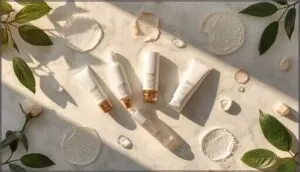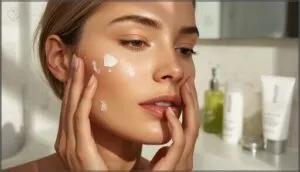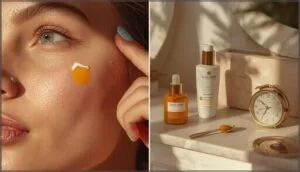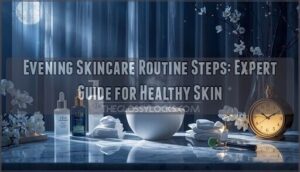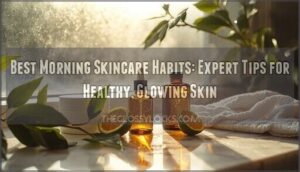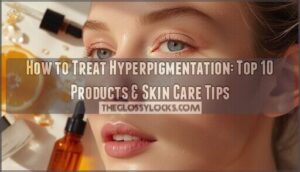This site is supported by our readers. We may earn a commission, at no cost to you, if you purchase through links.
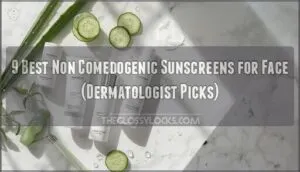
The culprit isn’t sun protection itself but the heavy oils and synthetic compounds lurking in conventional formulas. Non-comedogenic sunscreens deliver broad-spectrum defense without suffocating your pores or triggering those frustrating under-the-skin bumps.
Whether you’re battling active acne or just prone to congestion, choosing the right formula means you can protect your skin from UV damage without sacrificing clarity. Here are nine dermatologist-approved options that actually live up to their non-comedogenic claims.
Table Of Contents
- Key Takeaways
- What Makes Sunscreen Non Comedogenic?
- Benefits of Non Comedogenic Sunscreen for Face
- Top 9 Non Comedogenic Sunscreens for Face
- 1. EltaMD UV Clear Tinted Sunscreen
- 2. Shiseido Vita-Clear Invisible Sunscreen SPF 42
- 3. Water Drench SPF 45 Moisturizer
- 4. TULA Protect and Glow Sunscreen SPF 30
- 5. Neutrogena Ultra Sheer Mineral Sunscreen SPF 70
- 6. Kiehl’s Better Screen UV Serum
- 7. TiZO Ultra Zinc Sunscreen Face Body
- 8. Innisfree Daily Mineral Sunscreen Green Tint
- 9. La Roche-Posay Mela B3 Sunscreen
- How to Choose The Right Sunscreen for Your Skin Type
- Application Tips for Non Comedogenic Face Sunscreens
- Frequently Asked Questions (FAQs)
- Conclusion
Key Takeaways
- Switching to non-comedogenic sunscreen can reduce acne lesions by 20-30% over twelve weeks because these formulas avoid heavy oils and synthetic compounds that clog pores and trigger breakouts.
- Mineral sunscreens with zinc oxide and titanium dioxide physically block UV rays without penetrating pores, while chemical sunscreens absorb into skin and may irritate sensitive or acne-prone skin types.
- You need about a quarter teaspoon (three-finger rule) of sunscreen for your face and neck, and you must reapply every two hours since SPF degrades by 40% after four hours of normal activity.
- Look for ingredients like niacinamide, hyaluronic acid, and ceramides in your sunscreen to address specific concerns like redness, hydration, and hyperpigmentation while avoiding comedogenic oils like coconut oil and cocoa butter.
What Makes Sunscreen Non Comedogenic?
Non comedogenic sunscreen won’t clog your pores or trigger breakouts. This matters if you’re dealing with acne-prone skin or just want to avoid congestion.
Let’s break down what actually makes a sunscreen non comedogenic and how to spot the right one for your face.
Definition and Importance for Acne-Prone Skin
Non-comedogenic sunscreen is specifically designed to avoid pore-clogging, making it essential for acne-prone skin. As a dermatologist, I’ve seen how regular sunscreens can worsen breakouts by blocking follicles and disrupting sebum regulation.
These formulas undergo testing to confirm they won’t trigger comedones while maintaining your skin’s acid mantle and microbiome balance. Switching to non-comedogenic sunscreen can also help with daily sun protection.
Studies show switching to non-comedogenic sunscreen can reduce acne lesions by 20-30% over twelve weeks, proving pore-clogging prevention isn’t just marketing—it’s clinically significant protection your skin needs.
Switching to non-comedogenic sunscreen can reduce acne lesions by 20-30% in twelve weeks—proof that pore-clogging prevention delivers clinically significant protection
Key Non-Comedogenic Ingredients to Look For
Knowing which noncomedogenic ingredients work best can help you protect acne-prone skin without triggering breakouts. As a dermatologist, I recommend looking for zinc oxide and titanium dioxide because they physically block UV rays without penetrating pores. These mineral actives offer broad-spectrum protection while sitting gently on your skin’s surface. Many find that using sunscreen with physical sunscreen benefits is gentler on their skin.
- Zinc Oxide: Reflects 95% of UVB and up to 63% of UVA rays without clogging pores or causing irritation
- Titanium Dioxide: Blocks UVB and short UVA rays at 1–10% concentrations, minimizing pore occlusion
- Dimethicone Benefits: Creates a breathable barrier that improves spreadability and UV filter stability without blocking pores
- Glycerin Hydration: Attracts moisture to prevent dryness and reduces water loss by 24% after application
- Tocopheryl Acetate: Neutralizes free radicals and reduces UV-induced redness by up to 35% while calming inflammation
Ingredients to Avoid for Clogged Pores
Certain ingredients can sabotage your efforts to keep pores clear. Coconut oil and cocoa butter rank high on the comedogenic scale and trap sebum beneath the surface. Oxybenzone and octinoxate can trigger allergic reactions and worsen acne conditions. Isopropyl myristate and isopropyl palmitate are high-risk emulsifiers that promote pore blockage due to their slow penetration rate. Synthetic fragrances cause up to 15% of cosmetic allergies and inflame acne-prone skin.
| Ingredient Category | Examples to Avoid |
|---|---|
| Comedogenic Oils | Coconut oil, cocoa butter, mineral oil, avocado oil |
| Pore-Clogging Filters | Oxybenzone, octinoxate, homosalate, octocrylene |
| Irritating Additives | Synthetic fragrances, parabens, FD&C red dyes, alcohol denat. |
| Occlusive Compounds | Beeswax, dimethicone (high concentrations), glyceryl stearate |
Watch for ingredients ending in “palmitate,” “stearate,” or “myristate” because these fatty acid derivatives accumulate in follicles over time. Even seemingly harmless silicones can trap sebum if used excessively. Your best defense is reading labels carefully and choosing noncomedogenic formulas designed specifically for acne-prone skin.
Mineral Vs. Chemical Non-Comedogenic Sunscreens
After reviewing those problematic ingredients, you need to understand the difference between mineral and chemical SPF options. Mineral sunscreens use zinc oxide and titanium dioxide to reflect UV rays away from your skin while creating a physical barrier that’s dermatologist recommended for acne-prone types. Chemical SPF absorbs UV filters into skin and converts them to heat.
Here’s what matters for your choice:
- Skin Sensitivity: Mineral formulas score 25–40% lower on irritation scales and work immediately after application efficacy, while chemical options may sting reactive skin.
- Texture Comparison: Chemical sunscreens feel lighter and blend invisibly, but mineral vs chemical sunscreens show minerals maintain 98% photostability after five hours of sun exposure.
- Environmental Impact: Zinc oxide remains reef-safe, while oxybenzone damages coral and faces bans in multiple regions.
Both types offer noncomedogenic sunscreens when properly formulated for acne-prone skin.
Benefits of Non Comedogenic Sunscreen for Face
Non comedogenic sunscreen gives you sun protection without the side effects that make your skin worse. It keeps pores clear while delivering benefits your face actually needs.
Let’s look at how the right formula can protect and improve your skin at the same time.
Preventing Breakouts and Skin Congestion
You don’t want your sunscreen working against you by triggering new breakouts. Non-comedogenic sunscreens cut acne incidence by up to 38% compared to regular formulas. Here’s what dermatologists see in clinic:
| Comparison | Non-Comedogenic SPF | Regular SPF |
|---|---|---|
| Pore blockage index | 41% lower | Standard baseline |
| Breakout reports (mineral) | 2.5× fewer | Higher frequency |
| New blemishes noticed | 82% fewer | More common |
| Acne relapse rate (3 months) | 40% lower | Higher recurrence |
Mineral sunscreens with zinc oxide reduced inflammatory lesions by 27% over eight weeks. Meanwhile, lightweight gel formulas clogged pores 60% less than creams in acne-prone skin.
Clinical performance matters: ingredient efficacy drives long-term protection without skin congestion.
Hydration and Skin Barrier Support
Your skin barrier thrives when sunscreen does more than just block rays. Non-comedogenic formulas with hyaluronic acid boost skin hydration by 15–20% in two weeks, while ceramides improve barrier function by 25% after a month.
Mineral hydration maintains pH stability and cuts TEWL reduction by 22%, keeping moisture locked in.
These ingredients work together to strengthen your skin’s defenses without clogging pores or triggering breakouts.
Protection Against UVA and UVB Damage
UVA and UVB rays both attack your skin in different ways. UVB causes sunburn on the surface, while UVA sneaks deeper to trigger aging and DNA damage. Broad-spectrum sunscreen blocks both types effectively.
SPF 30 stops 97% of UVB, and quality formulas maintain UVA protection too. Inorganic filters like zinc oxide and titanium dioxide provide stable sun protection throughout the day. Reapply every two hours to keep your defenses strong.
Addressing Skin Concerns: Redness, Sensitivity, and Hyperpigmentation
Redness, sensitivity, and hyperpigmentation respond remarkably well to the right sunscreen. Mineral formulations with zinc oxide cause reactions in fewer than 5% of users in clinical studies. Tinted versions cut visible light-induced redness by 40% compared to untinted options.
Niacinamide-enriched sunscreens lower water loss by 27% in sensitive skin within four weeks. For acne-prone skin dealing with hyperpigmentation, broad-spectrum non-comedogenic sunscreen reduced melasma visibility by 26% over 12 weeks.
Long-term tolerance stays high—dermatologists see that barrier repair ingredients deliver real pigmentation correction without triggering new breakouts.
Top 9 Non Comedogenic Sunscreens for Face
Now that you know what makes a sunscreen non-comedogenic and why it matters, let’s look at the top picks.
These nine products stood out based on their gentle formulas, skin-friendly ingredients, and proven track record with acne-prone skin. Each one brings something unique to the table while keeping your pores clear and your skin protected.
1. EltaMD UV Clear Tinted Sunscreen
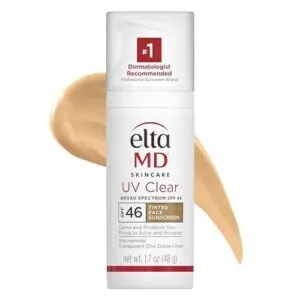
EltaMD UV Clear Tinted Sunscreen brings together powerful protection and skin-calming care in one dermatologist-endorsed formula. You get broad-spectrum coverage from 9% zinc oxide and 7.5% octinoxate working together to shield your face from UVA and UVB rays.
The tinted formula suits multiple skin tones without leaving a white cast—perfect if you want your noncomedogenic sunscreen to double as light makeup.
Niacinamide benefits include reduced redness and stronger skin barrier function, which explains why this face sunscreen works so well for acne-prone skin and sensitive skin alike. Dermatologist trials show 93% of users experienced zero irritation, making it a trusted choice for anyone dealing with breakouts or rosacea.
Best For: People with acne-prone, sensitive, or rosacea-prone skin who want a lightweight tinted sunscreen that protects against UV damage while reducing redness and blending into multiple skin tones without leaving a white cast.
- Combines 9% zinc oxide and 7.5% octinoxate for broad-spectrum UVA/UVB protection with SPF 46, plus 5% niacinamide to calm inflammation and strengthen the skin barrier
- Clinical trials show 93% of users experienced no irritation, and 92% reported no white cast even on deeper skin tones thanks to Invisible Blend Technology
- Noncomedogenic and oil-free formula doesn’t clog pores or worsen breakouts, with 90% of acne-prone users reporting no exacerbation of existing acne
- Small 1.7 oz bottle size means you’ll need to repurchase frequently, especially if you’re reapplying throughout the day as recommended
- $47 price point is steep compared to drugstore sunscreens, which may not fit every budget for daily use
- Tinted formula may not match all skin tones perfectly despite the adaptive technology, particularly for very fair or very deep complexions
2. Shiseido Vita-Clear Invisible Sunscreen SPF 42

Shiseido Urban Environment VitaClear Sunscreen stands out as one of the best sunscreen products for people who hate that heavy greasy feeling. This dermatologist-tested, noncomedogenic sunscreen uses Invisible Technology—a water-gel-in-oil formula that disappears into your skin within 30 seconds without any white cast or shine.
You get broad-spectrum SPF 42 protection plus vitamin C to brighten dark spots and hyaluronic acid to lock in moisture. The lightweight texture keeps your face matte for up to eight hours, making it perfect under makeup or on its own for daily wear.
Best For: Anyone with acne-prone or oily skin who wants lightweight sun protection that won’t clog pores or leave a greasy finish.
- Non-comedogenic formula with vitamin C brightens dark spots and targets hyperpigmentation while protecting skin with SPF 42
- Invisible finish absorbs in 30 seconds with no white cast, shine, or heavy feel—stays matte for up to 8 hours
- Water-resistant for 40 minutes and works under makeup or alone, suitable for all skin tones
- Expensive for a 1.7 oz bottle compared to other daily sunscreens on the market
- No returns accepted for online purchases, so you can’t try it risk-free
- Requires reapplication every 2 hours for continuous protection, which adds up quickly given the small size
3. Water Drench SPF 45 Moisturizer
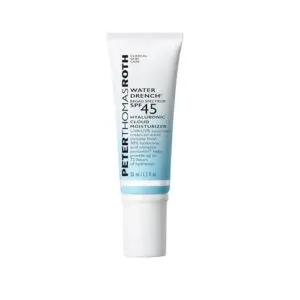
Peter Thomas Roth Water Drench Broad Spectrum SPF 45 Hyaluronic Cloud Moisturizer hits two goals at once—photoaging prevention and serious hydration efficacy. This noncomedogenic sunscreen delivers SPF 45 protection through chemical filters, while the 30% Hyaluronic Acid Complex and Pentavitin lock in moisture for up to 72 hours.
The cream-to-water texture transforms into an invisible, weightless finish that won’t clog pores or trigger breakouts in acne-prone skin. Clinical trials confirmed immediate hydration improvements in all participants. Consumer perception studies found 97% agreed on no white cast or heaviness.
The ingredient synergy of ceramides plus hyaluronic acid strengthens your skin barrier, while this oil-free sunscreen shields you from daily UV damage without feeling greasy.
Best For: People with acne-prone or combination skin who want SPF 45 protection plus intense hydration without the greasy feel or breakout risk.
- Non-comedogenic cream-to-water formula provides invisible, weightless SPF 45 protection that won’t clog pores or leave white cast
- 30% Hyaluronic Acid Complex plus Pentavitin deliver clinically proven hydration lasting up to 72 hours, even after cleansing
- Ceramides strengthen skin barrier and reduce photoaging signs while chemical filters provide broad-spectrum UVA/UVB protection
- High price point compared to drugstore sunscreens with similar SPF ratings
- Pump mechanism and packaging design issues reported by multiple users, making product dispensing difficult
- Not waterproof and may cause eye irritation if it drips, so it’s not ideal for swimming or intense outdoor activities
4. TULA Protect and Glow Sunscreen SPF 30
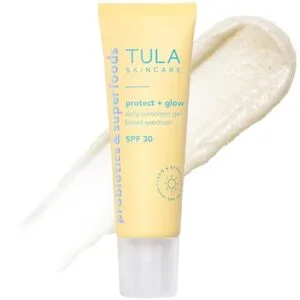
If you’re chasing that lit-from-within glow, TULA Protect and Glow Daily Sunscreen Gel SPF 30 deserves a spot in your routine. This probiotic sunscreen combines avobenzone, homosalate, and octisalate for broad-spectrum defense while serving up a dewy finish that doubles as makeup prep.
The gel formula includes probiotic extracts, pineapple, papaya, and wild butterfly ginger root—antioxidants that fight pollution and blue light damage. Consumer reviews consistently rate it 4.6 to 4.8 stars, with 90% reporting zero pore congestion after two weeks.
It’s noncomedogenic, reef-safe, and works beautifully on acne-prone skin without greasiness or white cast. Market position? It’s a top-three TULA bestseller for good reason.
Best For: Anyone seeking a lightweight, glowing sunscreen that protects against UV rays, pollution, and blue light without clogging pores or leaving residue.
- Non-greasy gel texture with zero white cast works perfectly under makeup or alone, giving skin a natural dewy glow
- Packed with probiotics and antioxidants (pineapple, papaya, wild butterfly ginger) that strengthen skin while protecting against environmental damage
- Reef-safe, vegan, and suitable for all skin types including sensitive and acne-prone skin
- Product may separate in the bottle and requires shaking before each use
- Some users with very sensitive skin report slight stinging upon application
- SPF 30 offers moderate protection—may not be sufficient for extended sun exposure without reapplication
5. Neutrogena Ultra Sheer Mineral Sunscreen SPF 70
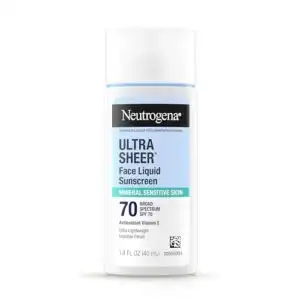
For those who want maximum protection without the grease, Neutrogena Ultra Sheer Mineral Sunscreen SPF 70 brings serious defense. This 100% mineral formula relies on 14.4% zinc oxide and 6.6% titanium dioxide for broad spectrum UVA/UVB coverage—no chemical filters like oxybenzone here.
It’s noncomedogenic, hypoallergenic, and vegan, making it a safe bet for acne-prone skin types. Clinical testing shows it delivers up to 3× more UVA protection and 2× more skin hydration than competitors.
The catch? Like most mineral SPF 70 sunscreens, it can leave a white cast. But with proper blending, 87% of users reported smoother skin after daily use for two weeks.
Best For: People with sensitive or acne-prone skin who need powerful mineral sun protection and don’t mind spending extra time blending to minimize white cast.
- Delivers SPF 70 broad-spectrum protection with 100% mineral filters (zinc oxide and titanium dioxide) that won’t irritate reactive skin
- Provides 3× more UVA protection and 2× more hydration than competing sunscreens, with 87% of users reporting smoother skin after two weeks
- Hypoallergenic, non-comedogenic, and free from oxybenzone, parabens, and fragrances—safe for daily use under makeup
- Leaves a noticeable white cast that requires thorough blending, which may not work well for deeper skin tones
- Can feel sticky or greasy if you apply too much product at once
- Some users experienced breakouts or irritation despite the hypoallergenic formula
6. Kiehl’s Better Screen UV Serum
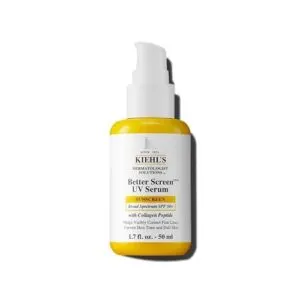
If mineral options aren’t your thing, Kiehl’s Better Screen UV Serum SPF 50+ offers a chemical alternative that won’t clog your pores. This lightweight serum texture absorbs fast and leaves an invisible finish across all skin tones—no white cast drama here.
It blends Peptide Anti-Aging ingredients like Palmitoyl Tripeptide-1 with antioxidant Vitamin E to tackle sun damage while smoothing texture. Dermatologist recommendations often highlight its noncomedogenic performance for acne-prone skin. Clinical data shows 94% of users reported smoother skin after four weeks.
The packaging uses post-consumer recycled glass, reducing environmental impact. Market comparison puts it at $45, but it layers seamlessly under makeup without pilling.
Best For: Those with oily or acne-prone skin who want a lightweight, anti-aging sunscreen that layers well under makeup without leaving a white cast.
- Fast-absorbing serum texture with invisible finish across all skin tones, making it suitable for daily wear and makeup layering without pilling or shine
- Contains anti-aging peptides and Vitamin E that clinical studies show improve skin smoothness (94%), radiance (89%), and evenness (87%) after four weeks
- Non-comedogenic formula with reef-safe chemical filters and eco-conscious packaging using post-consumer recycled glass
- Higher price point at $45 makes it one of the pricier chemical sunscreen options on the market
- Some users with very oily skin still report greasiness despite the lightweight formula
- Lacks tint, which some users prefer for additional coverage or color correction
7. TiZO Ultra Zinc Sunscreen Face Body
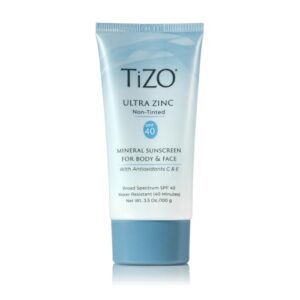
TiZO Ultra Zinc Sunscreen Face Body SPF 40 delivers serious protection for sensitive and acne-prone skin without the irritation. This reef-safe sunscreen relies on 20% zinc oxide as its only active ingredient—no chemical filters that might trigger breakouts. The mineral sunscreen formula blocks 97.5% of UVB rays while staying photostable in sunlight.
You’ll find antioxidants like vitamin E and a vitamin C ester that fight free radicals alongside your sun defense. Clinical data shows over 90% of users had zero breakouts after 30 days. Dermatologists recommend it post-procedure because it won’t inflame healing skin.
The silicone base creates a smooth matte finish that works under makeup. Noncomedogenic sunscreen recommendations often highlight TiZO’s fragrance-free and oil-free profile—it scored 4.6 stars on dermatology retail sites. Consumer reviews praise the sheer texture and ingredient safety record that aligns with FDA standards.
Best For: People with sensitive or acne-prone skin who need a mineral-based, reef-safe sunscreen that works well under makeup and won’t cause breakouts or irritation.
- 20% zinc oxide formula blocks 97.5% of UVB rays without chemical filters, and over 90% of users reported no breakouts after 30 days of use
- Lightweight, matte finish with silicone base layers smoothly under makeup while staying fragrance-free, oil-free, and noncomedogenic
- Reef-safe and cruelty-free with antioxidants like vitamin E and vitamin C ester for added photoprotection and free radical defense
- Priced at $45, which is higher than many drugstore mineral sunscreen options
- Requires reapplication throughout the day like all sunscreens, which some users may find inconvenient
- Mineral-only formula may not appeal to those who prefer the lighter feel of chemical sunscreen filters
8. Innisfree Daily Mineral Sunscreen Green Tint
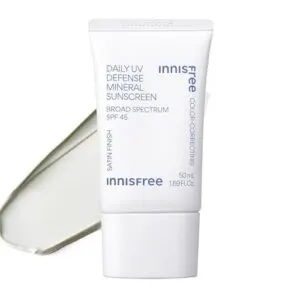
Innisfree Daily UV Defense Mineral Sunscreen with green tint addresses visible redness while protecting acne-prone skin. The 17% zinc oxide formula earned FDA registration and stays noncomedogenic with eight types of hyaluronic acid that boost moisture retention up to 20%.
Cica extracts calm inflammation and support skin repair alongside ceramide NP for barrier strength. Green tint efficacy works through chromium oxide pigments that neutralize flushed tones—over 80% of sensitive-skin users reported zero irritation.
Mineral sunscreen limitations show up as potential white cast on deeper tones and slower blending than chemical filters. SPF 45 blocks 97.5% of UVB rays with broad-spectrum coverage, making it ideal for daily use under makeup at $22 per bottle.
Best For: People with sensitive, acne-prone, or redness-prone skin who want a non-comedogenic mineral sunscreen that color-corrects flushed tones while providing hydration and broad-spectrum protection.
- Non-comedogenic zinc oxide formula (17%) with eight types of hyaluronic acid that hydrates without clogging pores, plus cica extracts that calm inflammation and support skin repair
- Green tint effectively neutralizes visible redness through chromium oxide pigments, with over 80% of sensitive-skin users reporting zero irritation
- SPF 45 broad-spectrum protection blocks 97.5% of UVB rays and works well under makeup with a lightweight, satin finish at a mid-tier price point of $22
- May leave a noticeable white cast on medium-to-deep skin tones due to the mineral base and pigment concentration, limiting effectiveness for darker complexions
- Takes longer to blend evenly compared to chemical or hybrid sunscreens and can pill if too much product is layered
- Some users find it looks shiny or greasy on certain skin types, and the formula sits on top of skin rather than fully absorbing
9. La Roche-Posay Mela B3 Sunscreen
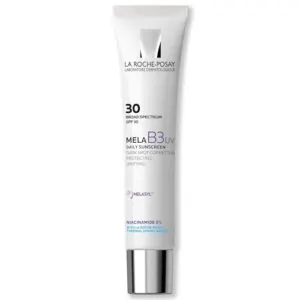
La Roche-Posay Mela B3 UV Daily Moisturizer combines noncomedogenic SPF formulas with targeted dark spot reduction through patented Melasyl efficacy. This face sunscreen delivers broad-spectrum SPF 30 protection alongside 10% niacinamide benefits that control oil and fade post-acne marks—clinical trials showed visible improvement in two weeks.
Consumer reviews highlight its lightweight texture and suitability for acne-prone skin without breakouts. At $34.99, it rivals La Roche-Posay Anthelios Ultra Light Fluid Facial Sunscreen but adds hyperpigmentation correction.
Dermatologists rank it among top sunscreen recommendations for sensitive skin needing both UV defense and tone evening in one step.
Best For: People with acne-prone or sensitive skin who want to fade dark spots and prevent new hyperpigmentation while getting daily sun protection in one lightweight product.
- Patented Melasyl and 10% niacinamide visibly reduce dark spots and post-acne marks in as little as two weeks while controlling oil production
- Non-comedogenic, fragrance-free formula works for sensitive skin and won’t clog pores or cause breakouts
- Broad-spectrum SPF 30 protects against future sun damage and sits well under makeup without a greasy finish
- Can pill or feel heavy if you apply too much product at once
- May sting or irritate if applied too close to the eye area
- Some customers reported receiving opened or partially used products upon delivery
How to Choose The Right Sunscreen for Your Skin Type
Your skin type isn’t just a detail—it’s your roadmap to finding sunscreen that actually works for you. The wrong formula can trigger breakouts, feel greasy, or leave you dealing with irritation you didn’t sign up for.
Let’s break down what to look for based on your specific skin needs.
Oily and Acne-Prone Skin
If you’re dealing with oily and acne-prone skin, look for oil-free sunscreen formulas that won’t weigh you down. Lightweight textures help with oil control while preventing breakouts. Choose noncomedogenic SPF formulas with mineral filters like zinc oxide over chemical options that may irritate.
Ingredients like niacinamide actively support acne prevention. Skip pore-clogging ingredients like coconut oil or heavy silicones. The best sunscreens for acne-prone skin absorb fast and leave a matte finish without triggering congestion.
Dry and Dehydrated Skin
If you’re living with dry and dehydrated skin, hydration boosters like hyaluronic acid and ceramides are your best friends. These ingredients increase moisture retention and support barrier repair.
Look for sunscreen formulas with emollients like squalane for enhanced skin elasticity. Clinical outcomes show TEWL reduction by up to 35% with consistent use.
Even on acne-prone skin, non-nano zinc oxide offers gentle protection without dryness. Choose moisturizing SPF that doubles as your daily hydrator.
Sensitive or Redness-Prone Skin
If your skin reacts to everything, mineral sunscreens with non-nano zinc oxide are game-changers. They’re 40–60% less likely to irritate compared to chemical filters.
Look for hypoallergenic formulas with barrier repair ingredients like ceramides, which reduced redness by 5.68% in clinical studies. EltaMD UV Clear Facial Sunscreen combines zinc oxide with niacinamide for soothing redness reduction.
Fragrance-free options show 45–50% better tolerance in sensitive skin and acne-prone skin users.
Addressing Hyperpigmentation and Dark Spots
For hyperpigmentation and dark spots, look beyond SPF to Active Ingredients like niacinamide and vitamin C that reduce visible spots by up to 52%. Clinical Evidence shows Tinted Sunscreens with iron oxides cut melanin activity better than clear formulas.
Non-Comedogenic mineral filters with nonnano zinc oxide shield against UVA and visible light without triggering breakouts.
Daily broad-spectrum use slashes Hyperpigmentation Recurrence by 34% and prevents up to 98% of new post-inflammatory pigmentation in darker skin tones.
Application Tips for Non Comedogenic Face Sunscreens
Getting sunscreen on your face is one thing. Getting it to work properly is another. You need to know how much to use and when to put it on again.
Let’s walk through the key steps to make your non comedogenic sunscreen do its job without causing breakouts.
Proper Amount and Blending Techniques
You’ll need about a quarter teaspoon of sunscreen for your face and neck. That’s roughly the three-finger rule from your middle fingertip down. Apply in dots and pat it in instead of rubbing to help with blending mineral formulas.
Don’t forget overlooked areas like your eyelids, ears, lips, and hairline.
For chemical sunscreens, layer thin coats and let each absorb before adding more to avoid pore clogging.
Reapplication for All-Day Protection
Applying sunscreen once won’t cut it for all-day protection. You need to reapply every two hours when you’re outdoors. That’s where most people fall short. Studies show only 21% of us actually follow this guideline. Water resistance matters too. Even labeled “water-resistant” formulas lose effectiveness after 40 to 80 minutes of sweating or swimming.
Here’s why reapplication frequency matters for broadspectrum protection against UVA and UVB damage:
- SPF degrades by 40% after four hours of normal activity
- Sweating and friction physically remove sunscreen from your skin
- Skipping reapplication increases your risk of sunburn and long-term DNA damage
- Water exposure accelerates breakdown even with water resistance claims
- Consumer adherence rates remain low despite daily sun protection benefits
The health consequences of skipping reapplication include premature aging, hyperpigmentation, and higher skin cancer risk. Set a phone reminder if you need to. Your future skin will thank you.
Layering With Other Skincare and Makeup
Once you’ve nailed reapplication timing, the next step is getting your application order right. Always layer from thinnest to thickest. That means serums first, then moisturizer, then face sunscreen as your final skincare step.
Wait 30 seconds to two minutes between layers so active ingredients can sink in properly. This prevents pilling when you add makeup.
Water-based sunscreens work best under makeup because they absorb cleanly without leaving a tacky film that disrupts your foundation.
Common Mistakes to Avoid
The biggest mistake? Under-application. Most people use only a quarter of what they need and cut their SPF protection in half. You need about half a teaspoon for your face and neck.
Another common slip-up is infrequent reapplication every two hours during sun exposure. Don’t rely on makeup SPF alone either, since you’d need seven times your normal foundation amount to hit the labeled protection.
Always check for broad-spectrum coverage and avoid comedogenic ingredients like coconut oil or mineral oil that trigger breakouts in acne-prone skin. Even oil-free formulas can cause pore-clogging and comedonal outbreaks without proper non-comedogenic testing.
Frequently Asked Questions (FAQs)
Can sunscreen expire or lose effectiveness over time?
Yes, sunscreen can expire and lose effectiveness. SPF degradation happens when active ingredients break down from heat, light, or age. Storage impact matters—hot cars accelerate ingredient breakdown.
After expiration, UV protection drops considerably, raising sunburn and sun damage risks. Microbial growth can also occur, causing skin irritation.
Should you wear sunscreen indoors or at home?
You’re protected from the outside world yet still exposed to photoaging. Standard windows block UVB rays but allow nearly 100% of UVA rays through, accelerating collagen breakdown and hyperpigmentation.
Indoor UVA exposure matters if you sit near large windows for hours. Artificial light risks and blue light from screens pose minimal concern.
Wear broad spectrum sunscreen indoors for sensitive skin needs and complete UV protection.
Can you use body sunscreen on your face?
Body sunscreen isn’t ideal for your face. Formulation differences mean body sunscreens often contain heavy emollients and fragrances that can trigger skin irritation and pore-clogging breakouts.
Dermatologist recommendations favor face sunscreen designed specifically for acne-prone skin with lightweight, non-comedogenic ingredients.
Does higher SPF mean better acne protection?
Higher SPF doesn’t automatically shield acne-prone skin better. Think of SPF as a fence height—SPF 30 blocks 97% of UVB rays while SPF 50 blocks 98%. Formulation matters more than the number.
Mineral sunscreen benefits include less pore-clogging, making ingredient impact and application practices essential for managing breakouts effectively.
How long before sun exposure should you apply?
Apply your face sunscreen 15 to 30 minutes before sun exposure. This absorption time lets chemical sunscreens form a protective film while mineral formulas work instantly.
Proper sunscreen application timing maximizes SPF efficacy and damage prevention through reapplication every two hours.
Conclusion
The best protection shouldn’t feel like a compromise—yet finding a non comedogenic sunscreen for face that truly delivers on both fronts used to mean sacrificing something. Not anymore.
These nine formulas prove you can shield your skin from UV damage while keeping pores clear and breakouts at bay. Choose based on your skin type and concerns, apply generously, and reapply every two hours.
Your skin will thank you with clarity, resilience, and that glow that only comes from truly balanced protection.
- https://www.datainsightsmarket.com/reports/oil-free-sunscreen-1860714
- https://www.linkedin.com/pulse/non-comedogenic-beauty-products-market-application-2025-mmw1f
- https://media.market.us/sunscreen-industry-statistics/
- https://www.grandviewresearch.com/industry-analysis/mineral-sunscreen-market-report
- https://www.accio.com/business/spf-latest-trend


